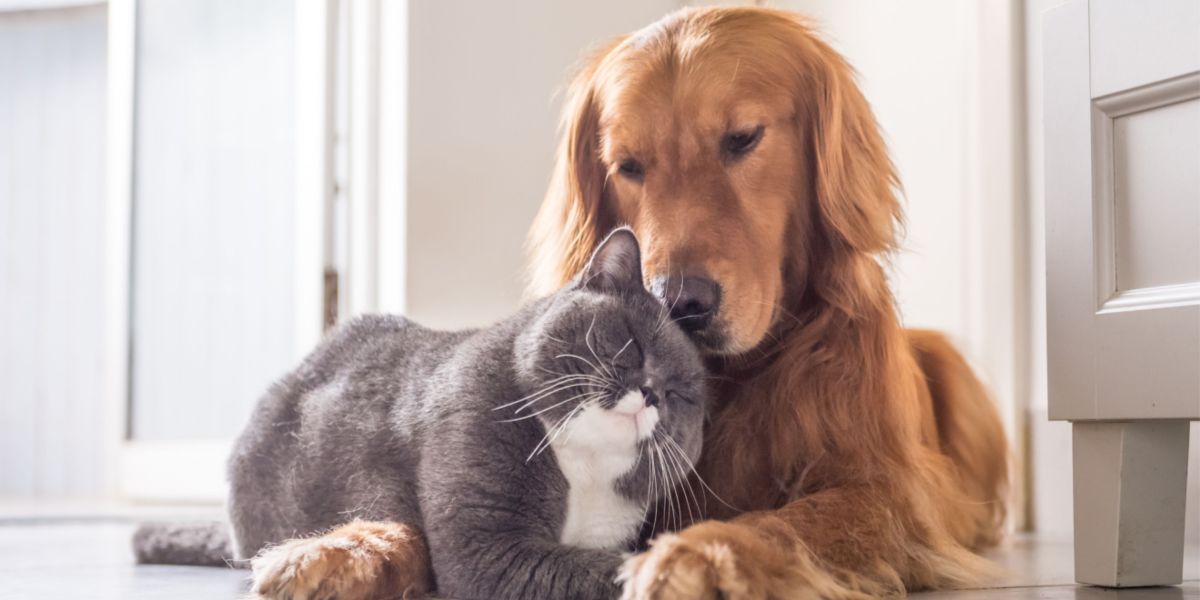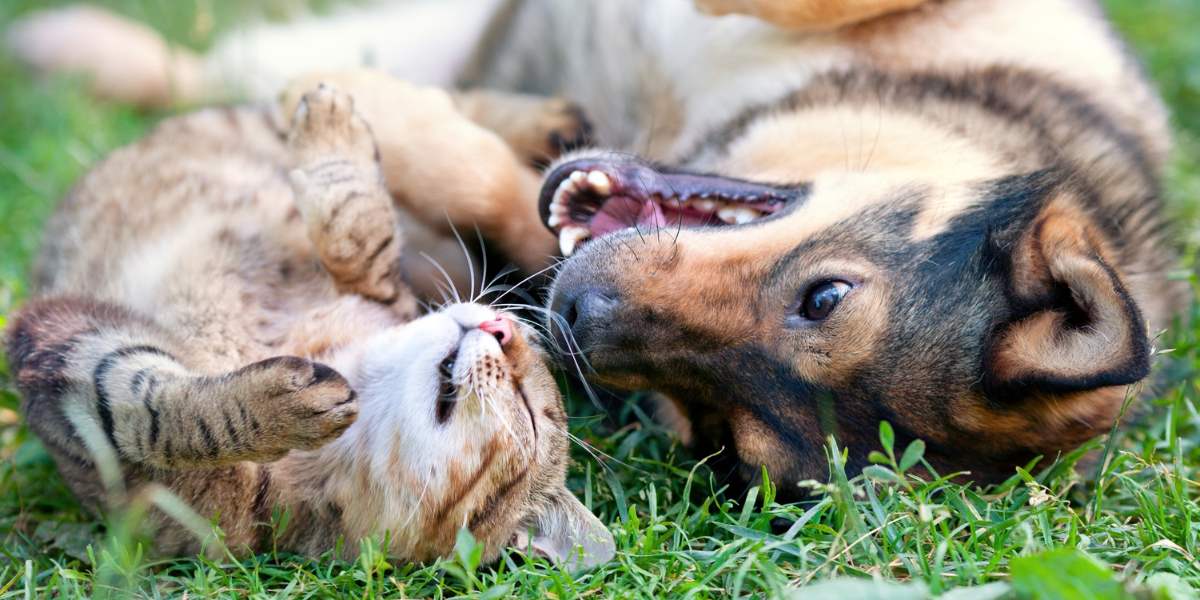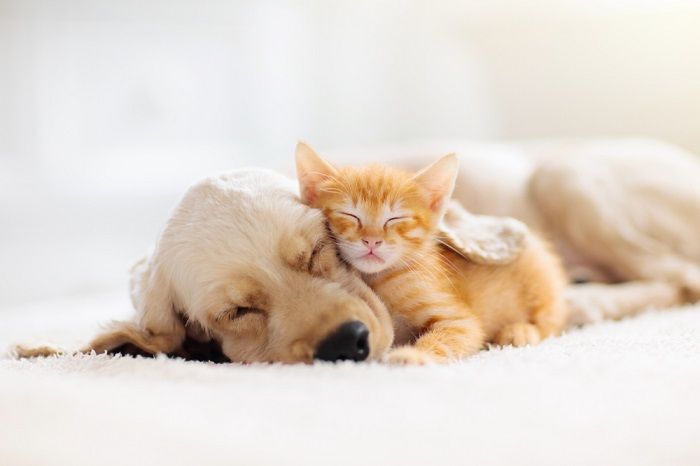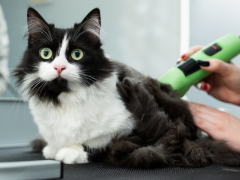Cats and dogs are often portrayed in the media as bitter enemies, unable to co-exist without fighting, chasing, and generally causing upset.
If you have a cat and dog or are about to add one or the other to your household, please be reassured, this doesn’t have to be the case! With the right individuals, good preparation, and an unhurried introduction, peaceful harmony can reign.
Currently dealing with a non-harmonious household? Imminently introducing a new species and unsure how to best go about it? Thinking about getting a cat, dog, or both and worried about your other pets? This article is for you! Read on for all you need to know, and our top tricks for pet unity.
Planning Ahead
Despite those stark contrasts, there are some surprising similarities between cats and dogs.
If you have yet to receive your new arrival, there are some ways to make the introduction smoother, for both you, the resident pet, and the new arrival. Making sure you are well prepared will set you up for success.
Here are some simple steps to consider before you bring your new family member home.
Think About Your Home Space
It’s important to remember that although the overall aim is to have a cat and dog who bond well and spend time together, they will likely need their own space, at least to start with. Think about your current pets. Where are their favorite places? Where do they spend most of their time?
Whether you’re introducing a new cat to a resident dog who likes to hang around in the kitchen with the family, or bringing home a new dog to a resident cat who mostly lounges around upstairs, it is important to keep some boundaries for the comfort of your resident cat or dog.
Both pets will need their own safe spaces, so try and design your home environment so that the different species have their own resources in their own areas so that they don’t have to cross paths too much, at least to begin with.
Also Read: Are Cats Smarter Than Dogs? Scientists Finally Have the Answer
Try Not To Make Sudden Changes
One of the several similarities between cats and dogs is that they are always quick to seize an opportunity if it arises.
New animals always come with a certain amount of “stuff”—food bowls, bedding, litter tray, toys, scratching posts, and more. Introducing a whole load of new objects into a home can be unsettling for an existing pet, so ease them in gently and add in new objects one at a time.
Try and be prepared and make these changes a few weeks in advance so that your pet is feeling settled and secure again when the real exciting addition appears! Some positive experiences with these new bits of pet equipment can be useful—some new cat bowls being added around feeding time with your existing pet receiving an extra treat for dinner, for example. Pets love routines, so try and keep to your usual schedule during this disconcerting time.
Also Read: 5 Heartwarming Cat And Dog Friendship Stories
Positive Experiences
If you recently welcomed a dog into the family, the best way to ensure harmony between pets is to take their relationship slowly.
New pets take up a lot of time and attention, which can cause some anxiety in your resident pets. It seems obvious, but this trick is an easy one to miss. It is important to make time for your resident pet, especially if they are now having to share space with the new addition, or perhaps are being kept out of certain areas of the house.
Extra playtime, praise, and positive interactions such as cuddles and strokes are all very important. Of course, your new pet will need lots of attention, too, so investing in some boredom-busting games or puzzle feeders may be helpful when you can’t be in two places at once!
Also Read: The 10 Best Cat Slow Feeders & Puzzle Feeders
The Introduction Process
Keep introductions brief and positive, never forcing interactions.
Your new pet should be kept in confinement initially, to avoid any negative experiences with the resident pets, and to have some peace and quiet to recover from their journey and new experiences.
Once your new cat or dog has had some time to assimilate into their new surroundings, it is time to start thinking about the first introductions. This is a process that is best done very gradually, with time and patience.
A new pet is a huge event in family life, and rushing the introduction process can end in tears. Behavior such as aggression can occur, but even minor hazards, such as barks and growls from a dog, or hisses and scratches from a cat, can leave a negative impression and make the whole process harder.
Here is a suggested schedule. This is applicable for both introducing a puppy or kitten, or for bonding adult animals. If you have two pets who don’t get along, you can always go back to stage one and start the process from the beginning, which may improve a struggling relationship.
Also Read: Do Cats Get Jealous of Dogs?
1. Swap Scents
Animal behaviorists aren’t convinced that cats are capable of feeling jealousy in the same form as humans.
Dogs and cats both use scent as an important part of communication. The different species will still be able to gather a lot of information about each other merely through sniffing at the other scents, and have strong instincts to communicate via smell. Start by rubbing a towel or cloth over the new pet and leave it in the resident pet’s area, and vice versa.
Try not to put the scented object too near to valued resources, such as food and water, in case it causes stress and stops the pet from accessing these needs. Give a reward when each pet shows interest in the other’s scent and continue this process daily until they no longer show any interest.
2. Exploring Each Other’s Territory
The next stage from scent swapping is allowing each animal to explore the area of your home where the other pet is currently living. This is best done with the other animal well out of the way to void the potential for a disastrous fight or chase.
Once they have returned to their own area, the resident pet can then return and investigate where the new pet has been. Do this both ways, so that both animals can explore each other’s home turf.
Also Read: How Do Cats Mark Their Territory?
3. Visual Contact
If all seems to be going well, the next step is to let the pets see each other. This would ideally happen when both pets are calm, with neither overly restrained, and with them both having the opportunity to escape. It is not recommended to place one animal in a crate and allow the other to approach—this can be very threatening and stressful.
The best method is to use a barrier such as a baby gate, which allows eyesight of each other but not direct contact. This can be partially covered with a blanket or towel to start with.
Use gentle restraint of the dog, such as a leash or harness, and allow the cat an escape route. In the beginning, have plenty of space between the two, and watch the cat and dog’s body language closely for signs that they are uncomfortable.
As they become more confident with this, gradually allow them closer to each other, relaxing your dog’s leash but still keeping sessions short and calm. Plenty of praise and reward will hopefully make these sessions positive.
Also Read: 6 Surprising Similarities Between Cats And Dogs
4. Direct Contact
Pets that are introduced as puppies and kittens often have an easier time bonding and learning to get along.
Eventually, your time and patience will have paid off, and it will be time to allow your pets to meet each other. This process can take a variable amount of time, which can depend on your animals’ breed and personality.
Some dog breeds have a high prey drive, some pups struggle to respond to basic commands, whereas others are naturally calmer and more tolerant. Some cats are shy and prone to anxiety and yet some are very sociable. Remember to take your time, listen to your pets’ cues, and approach the process slowly.
The first few sessions should be closely supervised, short, and only attempted when both pets are calm and relaxed. Keep the dog on a leash to start with, and ensure both pets have exits available.
Try not to intervene if there is some initial tension, but watch body language carefully and cut sessions short if things seem tense. Use treats, toys, and distractions initially to ease your pets into the sensation of closer contact.
Once this hurdle is complete, gradually build the time that your pets spend together until you are confident that they are safe to be left unsupervised.
Conclusion
Introducing a new pet to the household can be stressful, but following our simple step process will bring harmony and order to this exciting time. Always be prepared to set yourself up for success, ensuring all your new pets’ needs are met without disrupting your resident pet’s routine.
Follow our four steps: scent swapping, territory exploring, visual contact, and direct contact as a good base to set your pets up to be tolerant of each other.
Also Read: How to Get Cats To Like Each Other In 10 Simple Steps
Frequently Asked Questions
How long does it take for a cat to get used to a dog?
It can take weeks for a cat to get used to a new dog. It is recommended to keep them apart at first, and then implement a gradual introduction. Starting with scent swapping and territory exploration, and then moving on to visual and then direct contact can help smooth the process and avoid stress and conflict.
Can dogs form bonds with cats?
Yes, although dogs and cats are often portrayed as enemies in books and films, they are perfectly capable of forming social bonds. A careful, phased introduction gives the best chance of a positive bond forming rather than a negative association.
Why is my cat so scared of my dog?
Cats have strong self-preservation instincts, and dogs are generally larger than them, and very boisterous. Some dogs have strong prey drives and are known to chase cats. Your dog may be affecting your cat’s access to key resources such as a food bowl or litter box. Make sure your cat has a safe space away from the pups to reduce stress.


















